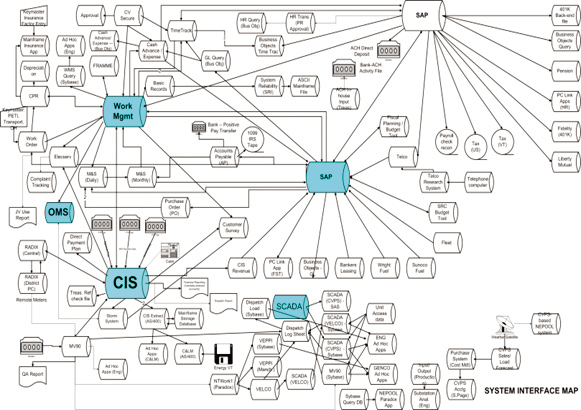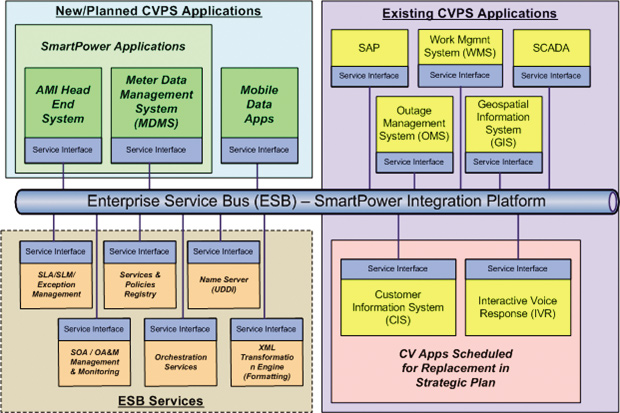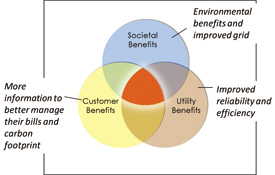Central Vermont Public Service (CVPS) is an investor-owned utility serving over 159,000 customers in 163 communities—the largest in the state. The company also has a long tradition of innovative rates and customer programs, and CVPS SmartPower® is a clear example of Central Vermont Public Service’s vision to provide exceptional customer service and become the best small utility in America. The CVPS SmartPower® program is the largest capital project in the utility’s history and is being partially funded by a $31 million U.S. Department of Energy Smart Grid investment grant.
In early 2010, CVPS needed a way to quickly integrate its existing customer information system (CIS) and back-office systems with a new meter data management system (MDMS). The MDMS would serve as a key information and integration hub for CVPS’s new Smart Grid systems. CVPS chose the eMeter Energy IP meter data management system (MDMS), implemented by Siemens, and is using this solution to power new efficiencies in a three-stage project that is helping to reduce costs and helping CVPS to abide by the terms of the Smart Grid investment grant.
As more utilities make the transition toward implementing Smart Grid solutions, it’s critical to not only address immediate requirements but to also consider future business needs. Doing so requires considering three key factors during the planning phase of a Smart Grid implementation, especially when evaluating a new MDMS – scalability and integration, impact on business processes and its effect on your customers.
Scalability and Integration Capabilities
Every utility has unique needs, but regardless of size, scope or their service region, all utilities need to ensure that legacy hardware and software fully integrates with their new MDMS solution, and that the MDMS will integrate with future technologies.
The right meter data management platform will support capabilities such as remote service connect and disconnect, data analysis and reporting, outage management analysis and monitoring capabilities, and validation, editing, and estimation (VEE). Additionally, the MDMS solution needs to be flexible. The MDMS must be capable of being integrated into a service-oriented architecture (SOA) and also support any point to point integration requirements that a utility may have. With these characteristics in place, the MDM software can enhance utility business processes by extracting data from multiple sources and integrate this data back to existing back-office systems to ensure a rapid rollout.

Non-Service Oriented Architecture

Service Oriented Architecture
Compared to a non-service oriented architecture (left), the CVPS SmartPower project has a service oriented architecture (right) that allows for easy integration of additional applications and capabilities.
Having a flexible and scalable MDMS solution in place will allow utilities to support regulatory policies and increasing reporting requirements required by State and National governments. As more government mandates require rapid smart meter deployment, it’s important to choose an MDMS solution that can easily accommodate growth and adapt as the Smart Grid evolves and new Smart Grid applications emerge.
The eMeter EnergyIP solution was chosen in part for its proven ability to scale with CVPS’ Smart Grid plans. This includes the rapid deployment of approximately 180,000 smart meters during 2012 and other future service offerings the company has planned related to advanced outage management and distribution automation.
Improved Business Efficiencies
CVPS’ Smart Grid implementation including the new meter data management system will yield an estimated annual savings of $2-5 million. Many of these savings stem from reductions in legacy business processes such as manually reading customer meters and the use of handheld meter reading devices, but also include decreases in the costs associated with truck rolls including fuel costs and vehicle repair charges. Even more, automated services made possible by the MDMS decrease the time employees would normally spend assessing the scope of an outage and identifying the level of utility response that is required, allowing personnel too much more quickly respond to outages or other grid issues.

Automated services made possible by the new meter data
management system will help decrease the time CVPS
employees need to spend assessing an outage on site.
Remote and automated meter reading capabilities, as well as remote connect and disconnect capabilities, will allow utilities to operate more efficiently. In addition, the data analysis tools provide by the MDMS will provide utilities with more precise information to support distribution equipment sizing and outage management decisions. None of these capabilities would be possible without access to timely, relevant data that represents a more accurate gauge of actual energy needs and consumption.
In addition to the above capabilities, the MDMS will help CVPS to improve reliability through a better understanding of customer power quality levels. The vast volume of data that the MDMS accumulates will allow distribution system engineers to improve reliability and reduce costs by sizing distribution equipment based on a better understanding of actual system load. Rate analysts will be able to leverage the interval data stored in the MDMS to model new rate options in support of emerging technologies such as electric vehicles based on load patterns for different customer classes. System Operators will be able to develop new load control programs so that utilities can partner with customers to more efficiently manage load during peak periods. In short, the MDMS will serve as a foundational tool for enabling business intelligence across the utility enterprise.
Benefits to Customers
The Internet and ubiquitous communications networks that exist today are fundamentally changing customers’ expectations about their interactions with service providers. With a bigger appetite for information, a continued need to save money and a heightened awareness of energy consumption, utilities must develop better ways to communicate with their customers (vs. ratepayers) at all points of contact. From their call center systems to monthly bills, utilities must take the opportunity to engage customers by providing them with richer information about their energy usage in a manner that helps customers to make informed choices about their consumption patterns and utility energy and rate programs.

The new MDMS ultimately delivers benefits to customers
by providing them with additional information about their
energy usage.
As the MDMS helps the utility to streamline its business processes, it also gives visibility to problems and opportunities that previously went undetected. The MDMS will allow utilities to provide customers with interval billing information, as often as 15 minutes in some instances, enable flexible billing schedules, and facilitate time-of-use rates. Even more, utilities can achieve marked improvements in their ability to help customers make critical pricing decisions during periods of peak demand and pass those savings along to customers in the form of peak time rebates.
The right MDMS solution can capture interval billing data from the smart meter, sending that information into the legacy CIS, and providing the utility with full meter-to-cash functionality. Complete synchronization of data from disparate systems further allows utilities to efficiently generate bills, minimizing manual intervention by using the real-time information taken from handheld meter reading devices and smart meters. Each day CVPS synchronizes the day’s customer transactions from CIS to the MDMS. These include transactions such as meter additions and replacements, rate changes, and general account changes. A complete synchronization of all CIS customer data is performed weekly between CIS and the MDMS. These processes ensure the MDMS and CIS are up-to-date and accurately reflect meter information necessary for the meter to cash billing process, from the smart meter to the MDMS providing the billing determinants for the CIS’ daily customer billing.
CVPS has already proven an industry leading example of a well executed Smart Grid implementation with its CVPS SmartPower¨ project. CVPS is continuing to work to fully realize the full capabilities of its Smart Grid deployment. The MDMS has been a key enabler and a mission critical system in helping CVPS to achieve its Smart Grid objectives. As it begins the next phase of the project this year, CVPS looks forward to the continued benefits of the SmartPower project.
About the Authors
 Jeff Breslen has been in the utility business for 28 years. He joined CVPS in 1985 as a software developer and has held various project management and leadership positions in the Application Development area. Jeff has an A.S in Data Processing and a B.S in Management Information Systems.
Jeff Breslen has been in the utility business for 28 years. He joined CVPS in 1985 as a software developer and has held various project management and leadership positions in the Application Development area. Jeff has an A.S in Data Processing and a B.S in Management Information Systems.
 Todd Kowalczyk has been involved with technology in a variety of different positions for the past 25 years. He joined CVPS in 2008 and is the Manager of CVPS’s Project Management Office. Todd has a B.S. in Computer Information Systems and an M.S. in Computer Science. In addition, he is a certified Project Management Professional and holds a Masters Certification in Project Management from George Washington University.
Todd Kowalczyk has been involved with technology in a variety of different positions for the past 25 years. He joined CVPS in 2008 and is the Manager of CVPS’s Project Management Office. Todd has a B.S. in Computer Information Systems and an M.S. in Computer Science. In addition, he is a certified Project Management Professional and holds a Masters Certification in Project Management from George Washington University.







